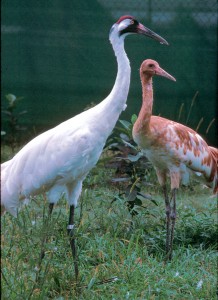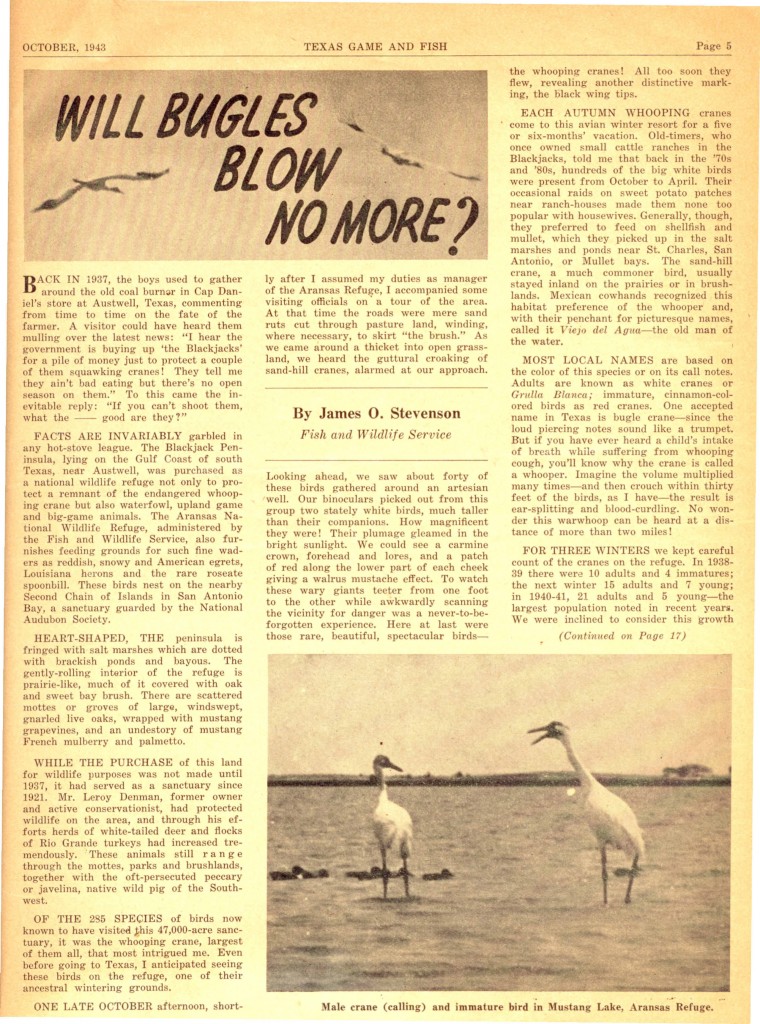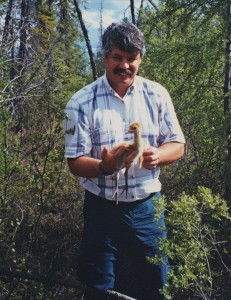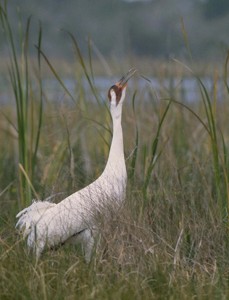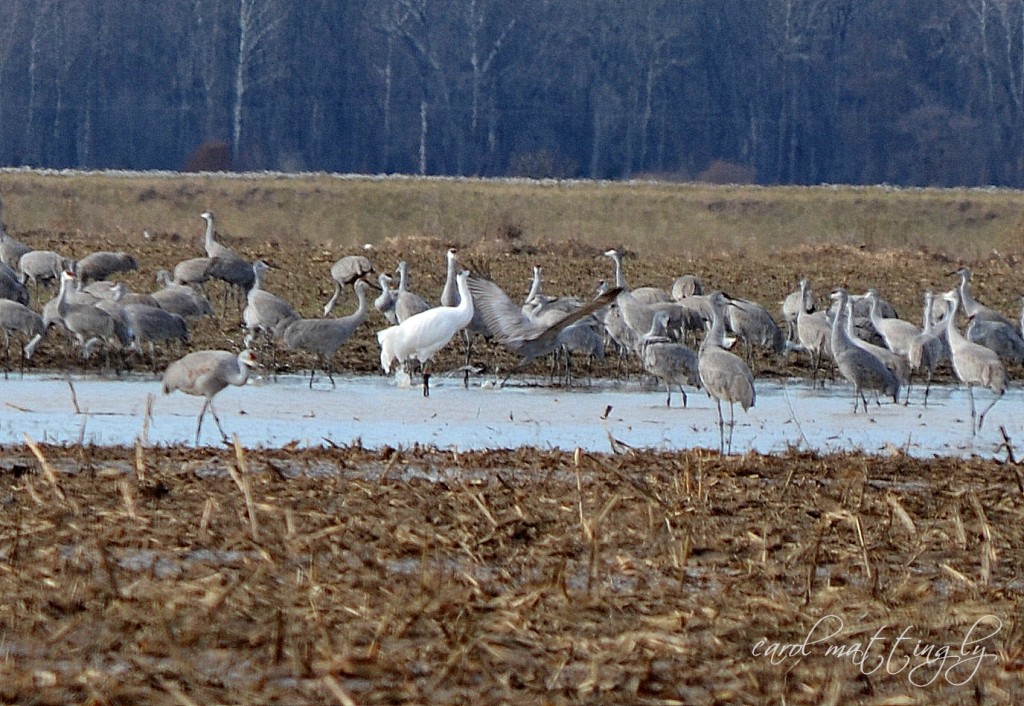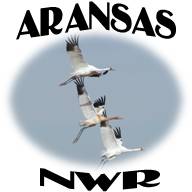Editor’s note: The Whooping Crane Conservation Association (WCCA) has received several inquiries during the past year quizzing us about why we believe whooping cranes are so cherished. One person wrote “who gives a dam about whooping cranes?” Answers to questions like these are not easy when you are responding to someone who is not interested in the natural world and all its wonders. Probably the best answer was written by Aldo Leopold in “A Sand County Almanac” -“There are some who can live without wild things, and some who cannot.” To further answer the questions, I reviewed a story we printed about Canus the whooping crane in “Grus Americana” (WCCA’s newsletter) in May 2003. A more detailed article about Canus appeared on Patuxent Wildlife Research Center web page. The article is posted below to provide an example of the “value” of one whooping crane and the people who cared for him. Hopefully this article will be read by a diverse group of people including United States Attorney’s, federal judges, wildlife law enforcement personnel, wildlife biologists, news reporters and citizens interested in whooping cranes:
CANUS and his 186 whooping crane descendants (1964 – 2003)
– USGS Author unknown. Written in 2003 –
To anyone who cares about endangered species, information about their numbers is always important. For whoopers, the rarest of all cranes, the annual count has been an environmental cliff-hanger for decades. In 1938, they were down to only 18 birds in the Aransas-Wood Buffalo flock, with only 11 remaining in the non-migratory Louisiana flock. Ten years later there were 31 birds in the Aransas-Wood Buffalo flock, but the Louisiana flock was down to a single bird. By 1950, the Louisiana flock was gone. The Aransas-Wood Buffalo flock’s numbers hovered on the edge of disaster for another decade. By 1964, there were still only 42 whooping cranes in the wild.
So, when a biologist doing aerial surveys in 1964 at Wood Buffalo Provincial Park (in Saskatchewan and Northwest Territories, Canada) discovered a young-of-the-year chick with a broken wing, he quickly took action. The chick’s parents were aggressive, rushing the helicopter when it came too close. The biologist knew that the parents could keep the chick safe from predators, but soon they would have to migrate, and their chick wouldn’t be able to follow them. He wouldn’t survive long once they were gone.
The biologist contacted officials in Canada and the US, and was advised to capture the bird. They did so the next day, chasing the chick through the marshland until it tripped on its dangling primaries and fell. The young crane, once captured, offered surprisingly little resistance. An x-ray showed a 2 inch sliver of charred wood had pierced the bird’s breast muscle and his wing was partially dislocated. They speculated that he had struck a burnt tree during early flight practice. To everyone’s surprise, the young crane showed no fear of his captors and readily accepted food including smelt, mealworms, hamburger and minced eggs.
The injured chick was later transferred to Monte Vista National Wildlife Refuge, Colorado where he did well until he suddenly became ill. Four veterinarians were brought in and treated the bird, who seemed near death. Amazingly, within a day the crane seemed to recover. But his bout of bad luck wasn’t over. While exercising in his pen one morning, he caught a toe in the bandage on his injured wing and fell, breaking the wing in two places. Again, the vets repaired the wing and he again recovered. It was shortly afterward that this young crane would be given the name “Canus” — CAN for Canada and US for the United States. A leg band was attached with the number “02-64001”.

CANUS the whooping crane in 1966 photo at Monte Vista National Wildlife Refuge, Colorado
In 1966, 02-64001 was transferred to what was then the beginnings of the U.S. Fish and Wildlife Service’s endangered species captive propagation program at the Patuxent Wildlife Research Center. 02-64001 was the first whooper in the program, and would become, over his long life, the foundation sire of the captive flock. His adjustment to life in captivity was a major factor in his ability to thrive in this new environment. Unlike many wild-caught animals, he never showed fear of his caretakers, and once he matured, would be quite aggressive to them, especially during breeding season.His injured wing would eventually be amputated. Without two fully functional wings, 02-64001 could not breed naturally. And so the biologists at Patuxent developed an Artificial Insemination (AI) program so that Canus, and other whooper males who were not fully-flighted, could reproduce. With such small numbers, every individual whooper was genetically valuable. As Patuxent’s endangered species program developed, eggs from Wood Buffalo were brought here to hatch, to develop a captive breeding flock that would genetically represent the wild flock in Aransas. This captive flock would be a safeguard — a genetic back-up — in case disaster wiped out the remaining wild birds.
Those early years were devoted to building the breeding flock and learning how to propagate whooping cranes. All the while, the numbers in the wild crept up slowly but surely. In 1966, when 02-64001 came to Patuxent Wildlife Research Center, there were 43 birds in the wild. In 1976, there were 69. Meanwhile, the scientists at Patuxent were discovering just how much there was to learn about the care, feeding, and propagation of whooping cranes.
All through the growth of Patuxent’s breeding flock, the development of proper incubation techniques, the perfecting of AI, the development of health care protocols, nutritional formulas, medical techniques, and chick rearing techniques, 02-64001 was there. Because he was such a long-term subject for Patuxent’s experiments, he literally taught us much of what we know about successful husbandry and breeding of captive Whooping cranes. He sired chicks with his mate through artificial insemination, and his semen was used here on many other female whoopers. It was even shipped, cryogenically preserved, to other facilities with whooping crane females.
Over the years, Canus and his mate raised many chicks together, and were fiercely protective parents. He was surprisingly healthy, after his initial rocky start, but he did have a bout of illness during the 1980s that he recovered from, and in the last five years he had some minor problems due to arthritis in his spine. We moved a panel heater into his pen in the hopes that would help and it may have, but we never actually saw him use it. He always knew when he was being observed. At the first site of humans approaching his pen, 02-64001 and Mrs. C would start going through their threat displays, letting everyone know that if they were thinking of coming in his pen, there would be trouble!
We first wrote about 02-64001 in these reports in June, 2000. At that time, we were following the progress of a young chick destined to be released in Florida, and 02-64001 was that chick’s grandparent. We also talked about some of Canus’ offspring who were now breeding adults in our program such as 02-84003 and 02-85001, our most productive pair, and also 02-83004 and 02-83003. Last year, we reported on Lucky, the first chick to fledge to wild whooper parents in the United States in 60 years — Lucky is a great-grandchild of Canus.
Over the course of his long life, 02-64001 was responsible for 186 whoopers, as sire, grand-sire, great-grandsire and beyond. That’s four times the number of whoopers who were alive the year he was captured. His descendants today are flying free from Wisconsin to Florida and reproducing naturally in the wild in Central Florida. Today, there are nearly 420 whooping cranes in the world — ten times as many as the year he was captured. 02-64001 was no small part of that. ( Approximately 600 whoopers exist in 2013 in the wild and I captivity.)
Early in the morning of Saturday, January 18, 2003, 02-64001 was found down in his feedshed near his heater. The technicians, Barb and Brian, experienced in emergency crane care, rushed him to the veterinary hospital on Center, and after placing him in a heated pen, contacted both the veterinarian on duty, Dr. Patty Bright, and our regular veterinarian, Dr. Olsen, who was attending crane meetings in California. In a short time, 02-64001 began to rally, lifting his head, looking around, and even attempting to stand. 02-64001 was only a few weeks shy of 39 years, and had had other sudden bouts of illness, but had always recovered, so we had hopes that this would follow that pattern. Dr. Bright treated 02-64001 with injectable fluids and steroids, and consulted with Dr. Olsen about an appropriate treatment regimen for the next few days. They decided to also administer antibiotics, and continue fluids and steroids until the bird was well enough for diagnostic blood work, which might tell them more about the nature of the problem.
Unfortunately, despite Canus’ attempt to rally, he died during treatment a few hours later. It was a terrible shock to all of us. In spite of his age, 02-64001 had always fought back against the odds and had always been so strong– it was hard to imagine anything defeating him.
To the people who care about the fate of endangered species, the numbers of animals is a natural focus. How few, how many. For those of us who work with these rare animals, each individual under our care is special, unique to themselves, and valuable. In the course of our daily work, we discover their personalities, their individual quirks, and become totally involved in their welfare and that of their offspring. In many ways, 02-64001 embodied our mission — he survived against incredible obstacles, thrived, and showed a wonderful spirit and will to live. Even while we grieve his loss, we have to celebrate the success that was his life. And in the offspring he has left us, he’ll live on, both here at Patuxent, and free in the wild.
UPDATES
Lucky, the whooper who fledged this year (2003) to wild parents in central Florida (these birds are part of the non-migratory flock that lives in Florida year round), has separated from his parents and is living on his own. It’s normal for young birds to separate from their parents a few months before breeding season. Lucky is associating with wild sandhills and whoopers, and picking good habitat. He has his own radio transmitter so that the Florida biologists can keep track of him. He should be almost completely white by now. * Unfortunately, Lucky was killed by a bobcat in 2010. To see a two part video about Lucky click on: https://whoopingcrane.com/whooping-crane-videos/ Then select “Lucky the Whooping Crane” (be sure and watch both Parts 1 and 2).
After reading the article and viewing “Lucky the Whooping Crane”, we trust that you will understand why many cherish these birds.
